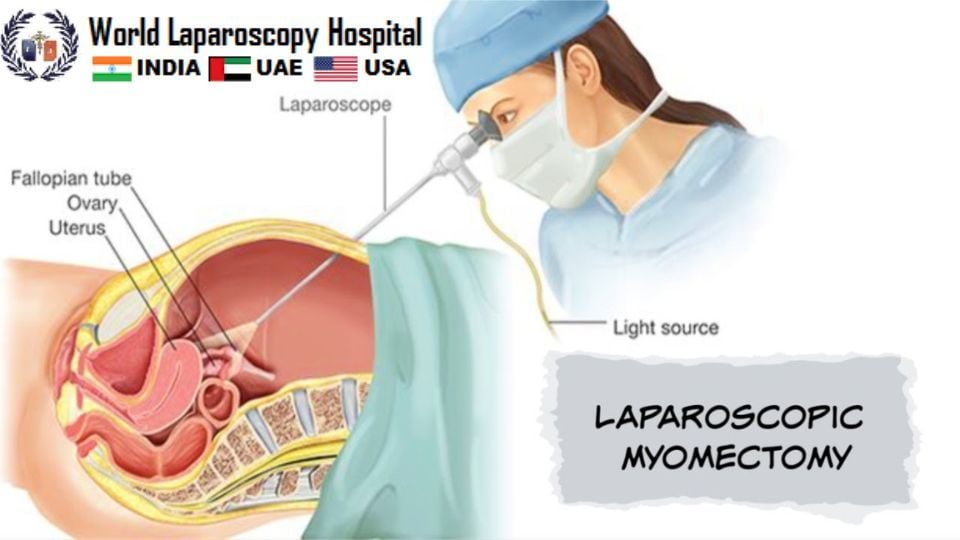This video demonstrate Laparoscopic myomectomy allows your surgeon toremove your fibroids through several small incisions. This may be done robotically. It's less invasive and recovery is faster than with abdominal myomectomy.

Laparoscopic myomectomy is a minimally invasive surgical procedure used to remove fibroids from the uterus. Fibroids, also known as leiomyomas, are noncancerous growths that develop in the uterus. Laparoscopic myomectomy is performed using a laparoscope, which is a thin, lighted tube with a camera attached to it. The laparoscope is inserted through a small incision in the abdomen, and the surgeon uses small instruments to remove the fibroids.
Laparoscopic myomectomy is generally considered a safe procedure with a low risk of complications. However, as with any surgical procedure, there is a small risk of bleeding, infection, and damage to surrounding organs or tissue. In rare cases, a hysterectomy may be necessary if the fibroids cannot be safely removed using laparoscopic myomectomy.
After laparoscopic myomectomy, women may experience some discomfort, bloating, and vaginal bleeding for several days. They may also need to avoid strenuous activities and sexual intercourse for a period of time to allow for proper healing. Women who have undergone laparoscopic myomectomy may need to have regular follow-up visits with their healthcare provider to monitor for any signs of fibroid recurrence.
Overall, laparoscopic myomectomy is a safe and effective treatment option for women with symptomatic fibroids who wish to preserve their fertility. However, as with any medical procedure, it's important to carefully weigh the potential benefits and risks before making a decision.
While laparoscopic myomectomy is generally considered a safe procedure, like any surgery, there are potential risks and complications that can occur. Some of the possible complications of laparoscopic myomectomy include:
-
Bleeding: There is a risk of bleeding during the surgery or in the days following the procedure. In some cases, blood transfusions or additional surgery may be needed to stop the bleeding.
-
Infection: Any surgical procedure carries a risk of infection, which can occur at the incision site or inside the pelvic cavity.
-
Damage to surrounding organs or tissues: There is a risk that the laparoscopic instruments may accidentally damage nearby organs or tissues during the surgery. This can cause bleeding, infection, or other complications.
-
Scar tissue formation: Scar tissue can form at the site of the incisions, which can cause pain and discomfort.
-
Recurrence of fibroids: While laparoscopic myomectomy is effective at removing existing fibroids, there is a risk that new fibroids may develop in the future.
-
Hysterectomy: In some cases, laparoscopic myomectomy may not be possible, and a hysterectomy (removal of the uterus) may be necessary instead.
It's important to discuss the potential risks and complications of laparoscopic myomectomy with your healthcare provider, as well as any concerns you may have about the procedure. Your healthcare provider can help you weigh the potential risks and benefits of laparoscopic myomectomy and determine if it's the best treatment option for you.
The advantages of laparoscopic myomectomy over traditional open surgery include:
-
Smaller incisions: Laparoscopic myomectomy is a minimally invasive procedure that uses small incisions in the abdomen. These incisions are typically only a few centimeters long, compared to the larger incisions required for traditional open surgery.
-
Less scarring: Because laparoscopic myomectomy uses smaller incisions, there is less scarring after the procedure. This can be particularly important for women who are concerned about the cosmetic appearance of their abdomen.
-
Shorter hospital stays: Because laparoscopic myomectomy is minimally invasive, most women are able to go home from the hospital the same day or the day after the procedure. This can help to reduce healthcare costs and improve patient comfort.
-
Quicker recovery times: Because laparoscopic myomectomy is less invasive than traditional open surgery, patients generally experience less pain and are able to return to their normal activities more quickly. Most women are able to return to work and other daily activities within a few days to a week after the procedure.
-
Preserves fertility: Laparoscopic myomectomy allows women to preserve their uterus and fertility, which may be particularly important for women who wish to have children in the future.
Other potential complications of laparoscopic myomectomy include:
-
Adhesion formation: Adhesions are bands of scar tissue that can form between organs or tissues. Adhesions can cause pain and discomfort, and in some cases, they can cause bowel obstruction or infertility.
-
Anesthesia complications: Laparoscopic myomectomy is performed under general anesthesia, which carries a risk of complications such as allergic reactions or respiratory problems.
-
Deep vein thrombosis: Surgery increases the risk of blood clots forming in the deep veins of the legs, which can be life-threatening if they travel to the lungs.
-
Urinary tract injury: There is a risk that the laparoscopic instruments may accidentally damage the bladder or ureters (the tubes that carry urine from the kidneys to the bladder).
Overall, laparoscopic myomectomy offers several advantages over traditional open surgery, including smaller incisions, less scarring, shorter hospital stays, quicker recovery times, and preservation of fertility. However, as with any medical procedure, it's important to carefully weigh the potential benefits and risks before making a decision.
| Older Post | Home | Newer Post |




